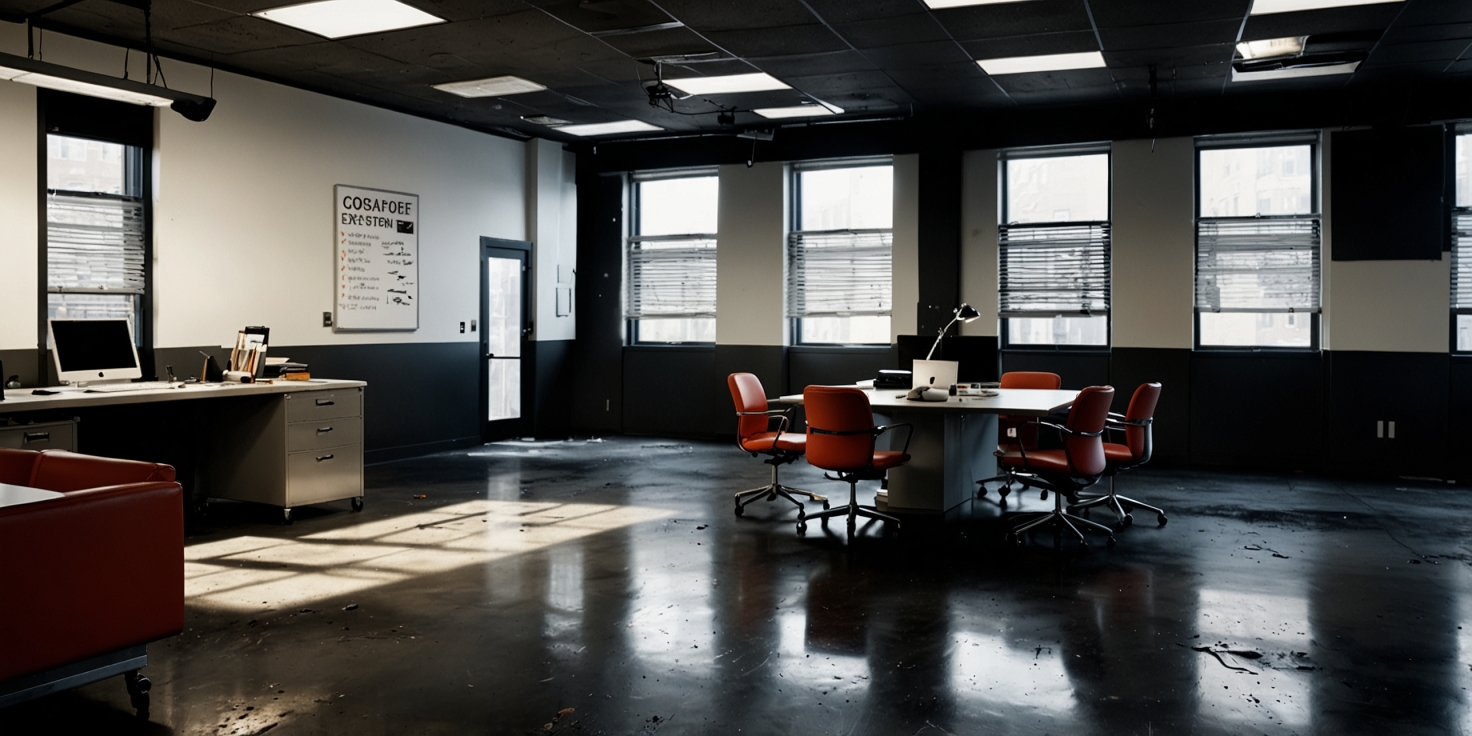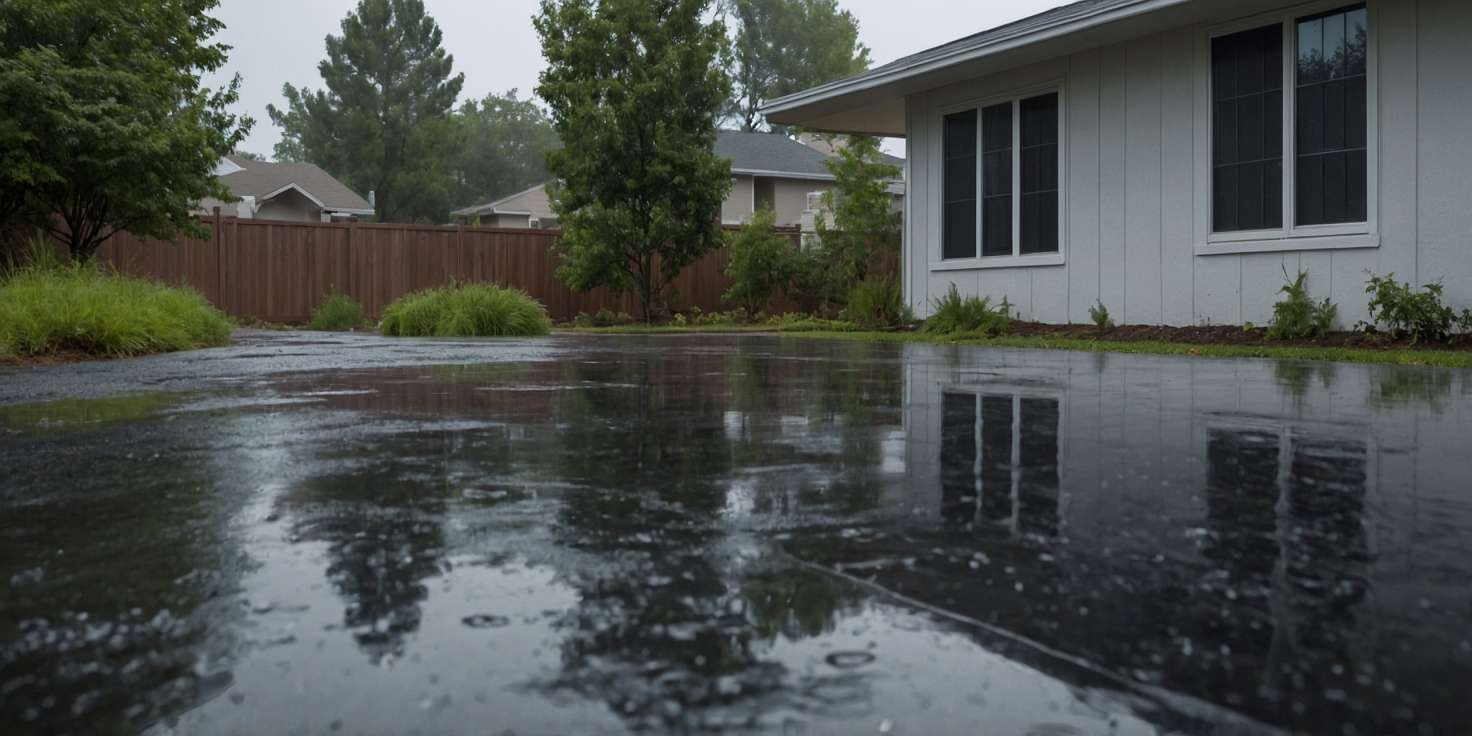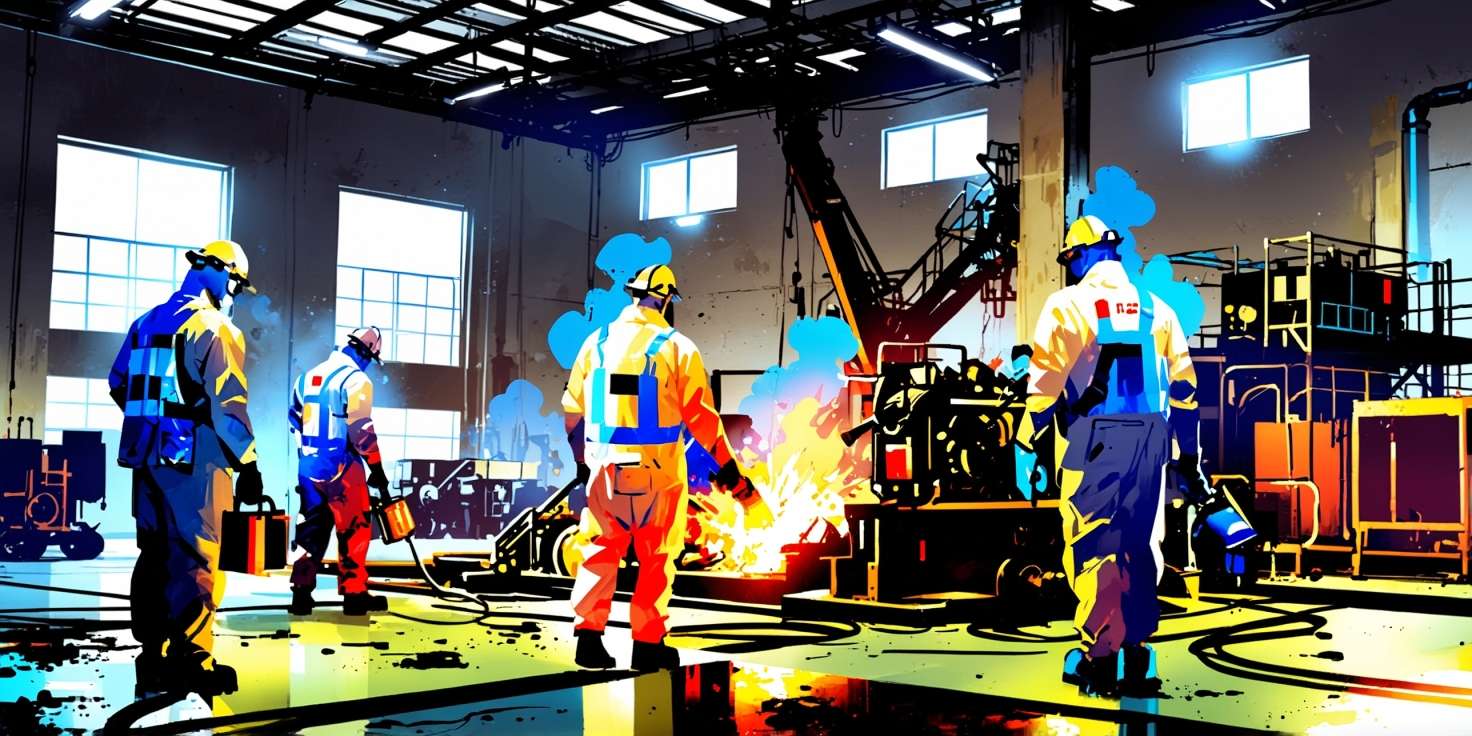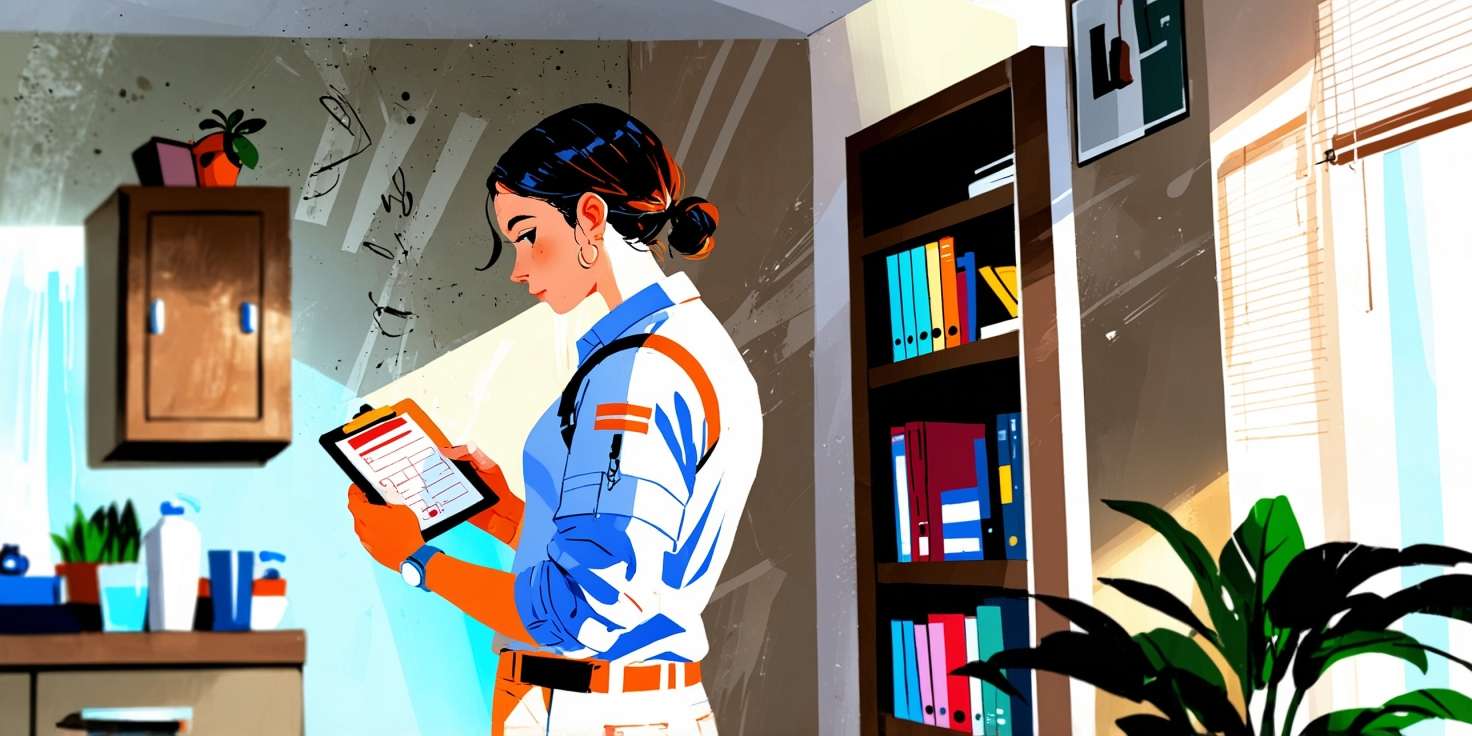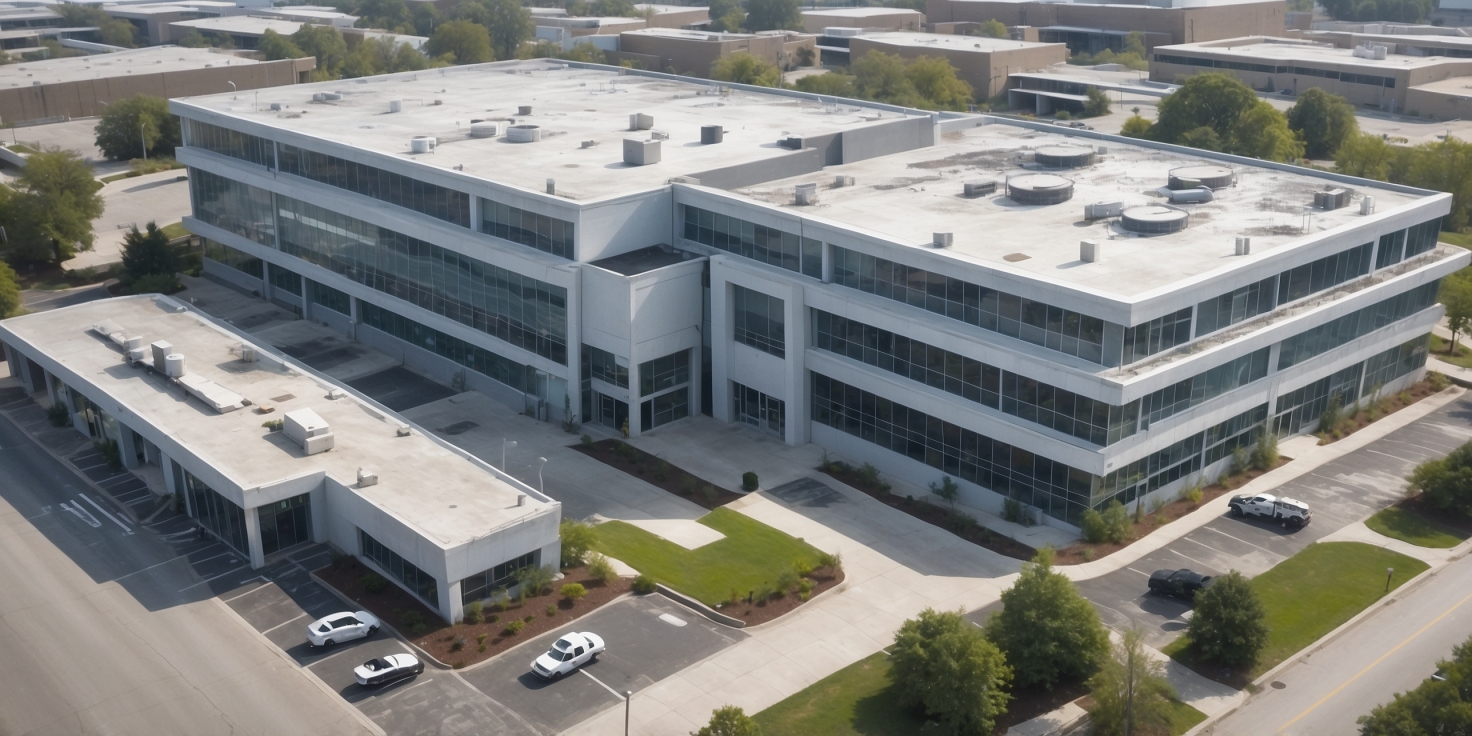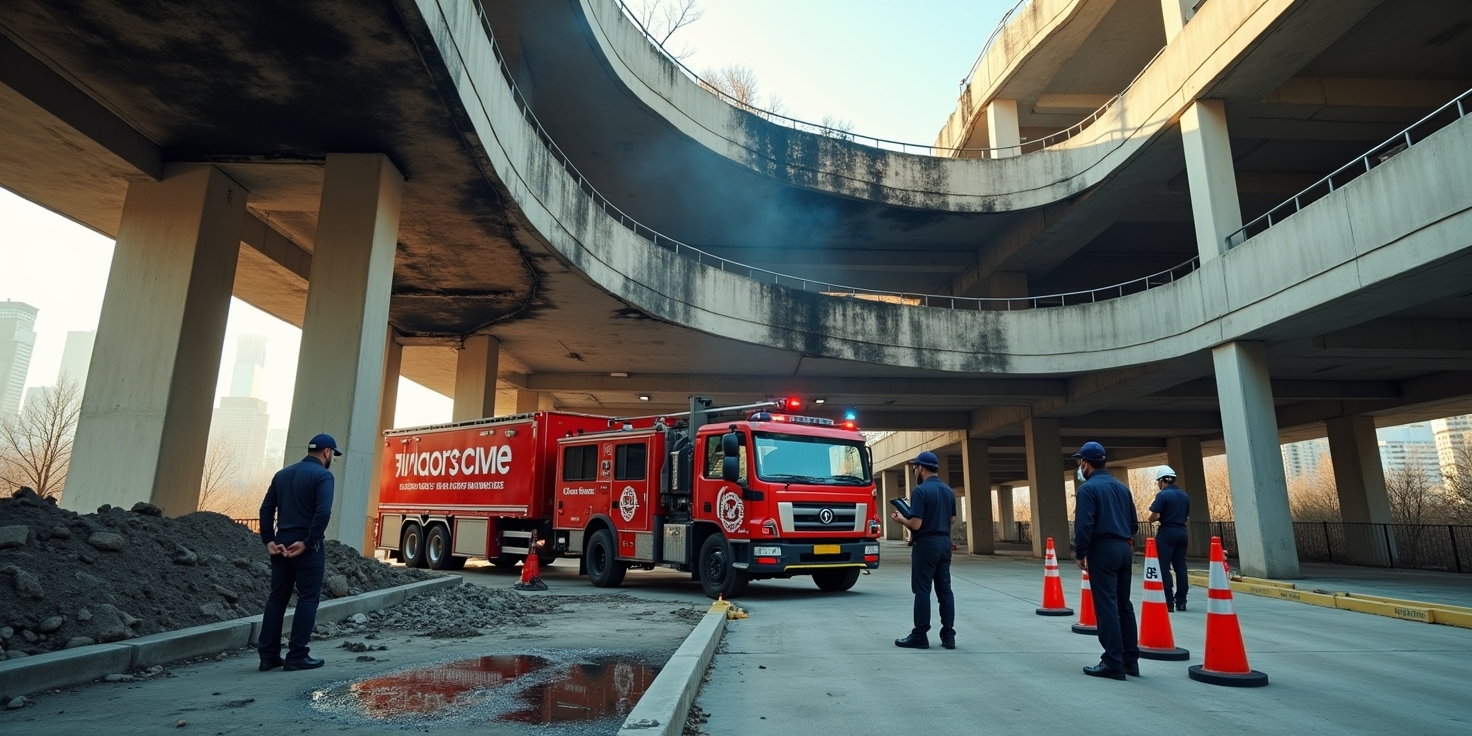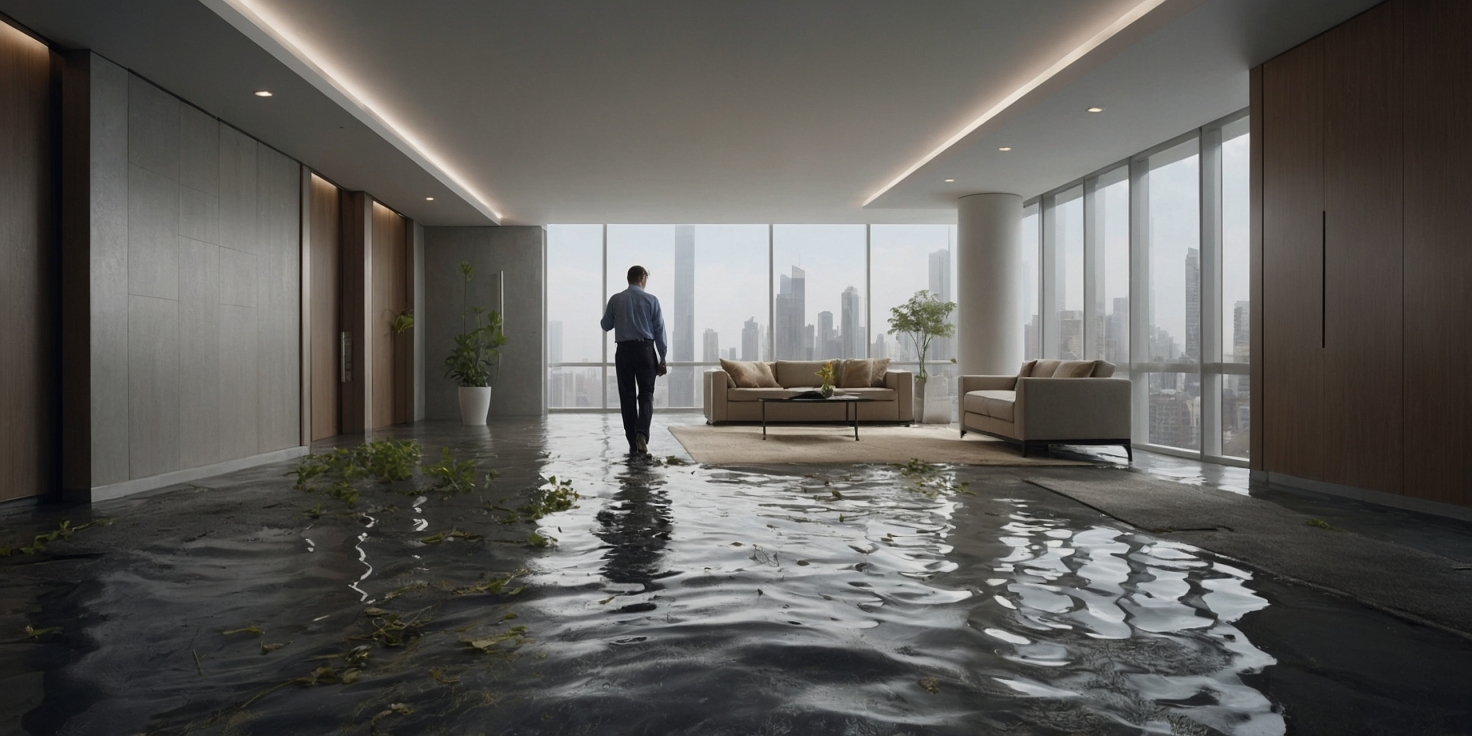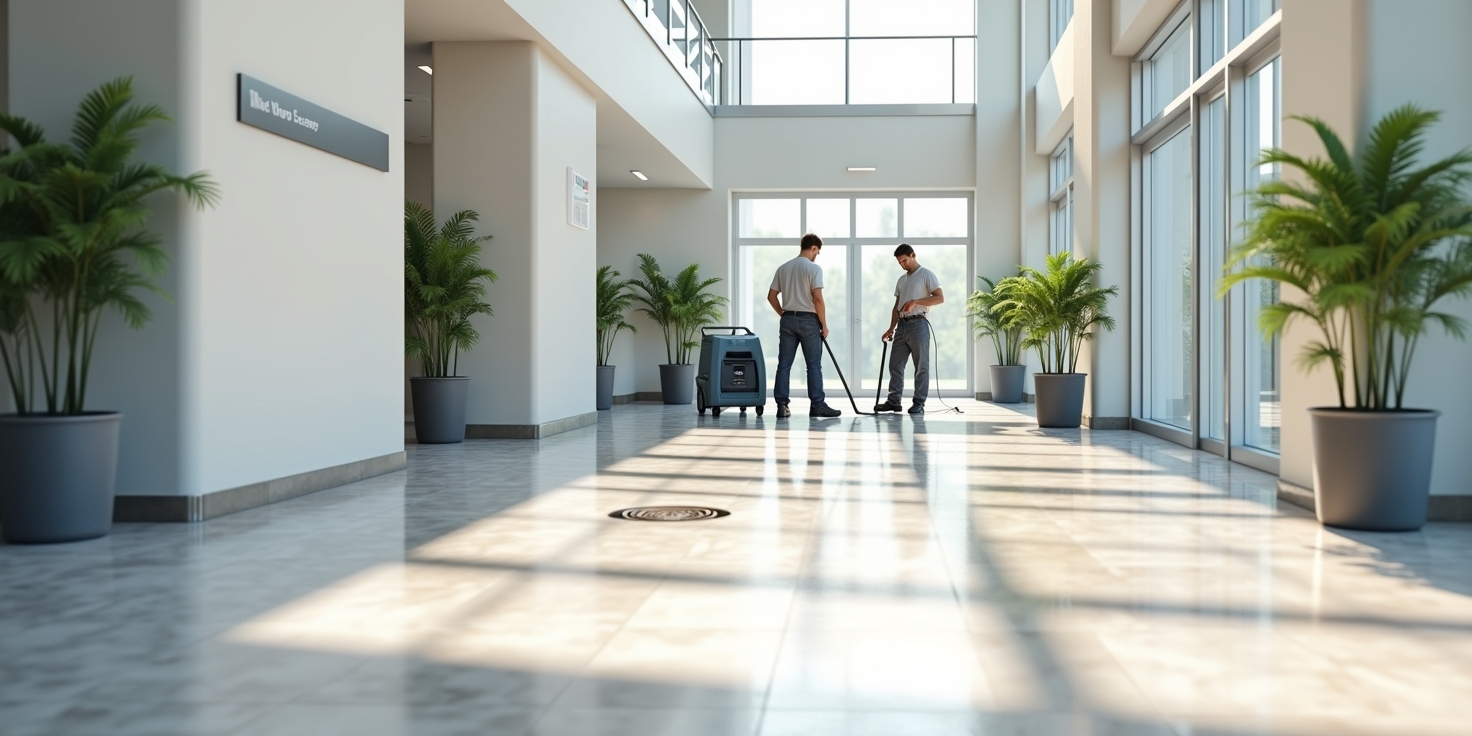Experiencing fire damage in parking structures can be overwhelming and hazardous, especially when it threatens the safety of vehicles, infrastructure, and public access. Understanding how to handle fire damage in parking structures is essential for property managers, building owners, and emergency response teams. At COMMITTED TO QUALITY SERVICE, we specialize in fast, friendly, and professional fire damage restoration, ensuring your structure is safe, secure, and fully functional as quickly as possible. With our expert team and advanced equipment, we mitigate fire-affected areas efficiently, preventing further structural damage and reducing downtime. Whether you’re dealing with smoke damage, structural weakening, or soot contamination, our comprehensive fire damage services are designed to restore your property with minimal disruption. Call us now at 855-933-7935 for immediate assistance and expert support in fire damage restoration for parking garages and commercial structures.
Understanding the Risks of Fire in Parking Structures
Parking structures, often perceived as low-risk environments, are in fact susceptible to a range of fire hazards that can result in significant damage, financial loss, and safety concerns. Understanding the risks associated with fire in these facilities is essential for property owners, facility managers, and emergency responders. Fires in parking structures can be caused by a variety of factors, including vehicle malfunctions, electrical faults, arson, and the improper storage of flammable materials. These risks are compounded by the unique architectural and operational characteristics of parking garages, such as limited ventilation, high vehicle density, and often minimal human presence during off-peak hours.
One of the primary causes of fire in parking structures is vehicle-related incidents. According to the National Fire Protection Association (NFPA), an estimated 16 percent of structure fires in parking garages are caused by vehicles themselves. These fires can result from fuel leaks, electrical system failures, or overheating engines. Once ignited, a vehicle fire can quickly spread to adjacent vehicles and structural components, especially in tightly packed garages. The presence of combustible materials such as tires, upholstery, and fuel further accelerates the spread of fire.
Electrical systems within parking structures also pose a significant fire risk. Faulty wiring, overloaded circuits, and malfunctioning lighting systems can all serve as ignition sources. In older parking facilities, outdated electrical infrastructure may not meet current safety codes, increasing the likelihood of electrical fires. Regular maintenance and inspections are crucial to identifying and mitigating these risks before they result in a fire.
Another contributing factor is the storage of flammable materials. Some parking structures, particularly those attached to commercial or residential buildings, may be used to store cleaning supplies, maintenance equipment, or even construction materials. If these items are not stored properly, they can become a fire hazard. Additionally, the presence of trash or debris, especially in poorly maintained garages, can provide fuel for a fire and hinder evacuation efforts.
Arson is another risk that cannot be overlooked. Parking structures, especially those with limited surveillance or security, can be attractive targets for intentional fires. The open design and multiple access points of many garages make it easier for individuals to enter undetected. Implementing security measures such as surveillance cameras, controlled access points, and regular patrols can help deter such activities.
The design and layout of parking structures also influence fire risk and response. Many garages are constructed with concrete, which is fire-resistant, but not fireproof. Prolonged exposure to high temperatures can compromise the structural integrity of concrete, leading to spalling or even collapse. Additionally, the open-air design of many parking structures can create wind tunnels that exacerbate the spread of fire and smoke. Limited visibility, narrow lanes, and low ceilings can also hinder firefighting efforts and evacuation procedures.
"The unique design and usage patterns of parking structures make fire detection and suppression more challenging compared to other types of buildings," notes a report by the NFPA.
Early detection is critical in minimizing fire damage in parking structures. However, many garages lack comprehensive fire detection systems. Smoke detectors and fire alarms may not be installed in open-air garages due to environmental factors such as dust, humidity, and temperature fluctuations, which can cause false alarms. As a result, fires may go undetected until they have grown significantly, making them harder to control.
Sprinkler systems, while effective in many building types, are not always present in parking structures. According to the NFPA, only 24 percent of parking garage fires occur in facilities equipped with sprinklers. The absence of automatic fire suppression systems can lead to more extensive damage and increased risk to human life. Installing and maintaining these systems can significantly reduce the impact of a fire.
The human factor also plays a role in fire risk. Drivers may leave engines running, improperly dispose of cigarettes, or perform unauthorized repairs within the garage. These actions can inadvertently start fires. Educating users about fire safety and enforcing strict usage policies can help mitigate these risks.
To illustrate the real-world impact of parking structure fires, consider the following examples:
- In 2018, a massive fire at a multi-story parking garage in Liverpool, UK, destroyed more than 1,400 vehicles. The fire was believed to have started in a single vehicle and quickly spread due to the lack of sprinklers and the high density of cars.
- In 2021, a fire in a parking structure at Newark Liberty International Airport in New Jersey led to the evacuation of the facility and significant delays. The fire was traced to an electrical fault in a parked vehicle.
- In 2023, a parking garage in Los Angeles experienced a fire that caused structural damage and required extensive repairs. Investigators found that improperly stored flammable materials contributed to the rapid spread of the fire.
These incidents underscore the importance of proactive fire risk management in parking structures. Property owners and managers must prioritize regular inspections, maintenance, and upgrades to fire detection and suppression systems. Collaboration with local fire departments can also enhance preparedness and response capabilities.
For those seeking professional assistance in assessing and mitigating fire risks, companies like Projekt Restoration offer comprehensive services tailored to the unique needs of parking structures. Their expertise in fire damage restoration, combined with a deep understanding of building codes and safety standards, ensures that facilities are not only restored after a fire but also better protected against future incidents.
Additionally, understanding the broader context of building safety and restoration can be beneficial. Learn more about Projekt Restoration’s commitment to excellence by visiting their our mission page. This resource provides insight into the company’s values and approach to disaster recovery.
For further reading and resources on fire safety in parking structures, consider the following:
- National Fire Protection Association (NFPA) – Offers guidelines and statistics on fire safety in various building types.
- U.S. Fire Administration (USFA) – Provides educational materials and data on fire incidents across the country.
- Occupational Safety and Health Administration (OSHA) – Contains regulations and best practices for workplace and facility safety.
In conclusion, while parking structures may not seem like high-risk environments, the reality is that they are vulnerable to a range of fire hazards. From vehicle malfunctions and electrical faults to arson and poor maintenance, the potential for fire is significant. By understanding these risks and taking proactive measures, property owners can protect their investments, ensure occupant safety, and minimize the impact of fire-related incidents.
Common Causes of Fires in Parking Garages
Parking garages, while essential for urban infrastructure, can be surprisingly vulnerable to fire hazards due to a variety of contributing factors. One of the most common causes of fires in parking structures is vehicle-related issues. Cars parked in these facilities may have mechanical problems such as fuel leaks, electrical malfunctions, or overheating engines. These issues can easily ignite a fire, especially when flammable fluids like gasoline or oil are involved. In some cases, fires start when a vehicle is left running or when a recently driven car with a hot engine comes into contact with combustible materials. Additionally, electric vehicles, though generally safe, can pose risks if their batteries are damaged or improperly charged, leading to thermal runaway and potential ignition.
Another significant cause of fires in parking garages is human negligence. Careless behavior such as improperly discarded cigarette butts, unauthorized use of open flames, or even small-scale vandalism can result in devastating consequences. In some instances, individuals may use parking garages for unauthorized activities, including makeshift repairs or storage of flammable materials, which significantly increases the risk of fire. Arson, though less common, is another human-related factor that cannot be overlooked. Whether intentional or accidental, these actions can quickly escalate in a confined space like a parking garage, where ventilation is limited and flammable substances are often present.
Electrical system failures within the parking structure itself also contribute to fire outbreaks. Faulty wiring, overloaded circuits, and outdated electrical panels can all become ignition sources. These issues are particularly dangerous in older parking facilities that may not have been updated to meet current safety codes. Lighting systems, security cameras, and electric vehicle charging stations all rely on electrical infrastructure that, if not properly maintained, can pose serious fire hazards. Regular inspections and upgrades are essential to mitigate these risks and ensure the safety of both vehicles and occupants.
The accumulation of combustible materials is another overlooked but critical factor. Trash, leaves, paper, and other debris can gather in corners or under vehicles, especially in open-air garages. These materials can easily catch fire from a small spark or heat source. In some cases, maintenance lapses allow these materials to build up over time, creating a highly flammable environment. Routine cleaning and proper waste disposal are essential preventive measures that can significantly reduce fire risks.
Environmental factors also play a role in parking garage fires. Extreme heat, especially during summer months, can exacerbate existing vulnerabilities. For instance, high temperatures can increase the volatility of fuel vapors or cause electrical components to overheat. In regions prone to wildfires, embers carried by wind can enter open parking structures and ignite flammable materials. Moreover, garages located in flood-prone areas may experience water damage that compromises electrical systems, indirectly increasing the risk of fire. Understanding how to identify and address these environmental threats is crucial for comprehensive fire prevention.
Mechanical equipment used within parking garages, such as elevators, ventilation systems, and automated parking systems, can also be sources of fire if not properly maintained. Malfunctions in these systems can generate heat or sparks that ignite nearby materials. For example, a malfunctioning ventilation fan could overheat and cause a fire, especially if it is surrounded by dust or debris. Regular maintenance and adherence to safety standards are vital to ensure that these systems do not become fire hazards themselves.
In some cases, fires in parking garages are the result of construction or renovation activities. Welding, cutting, or grinding operations can produce sparks that ignite flammable materials if proper precautions are not taken. Contractors may also store hazardous materials on-site, increasing the risk of accidental ignition. It is essential that all construction activities in parking structures follow strict fire safety protocols, including the use of fire-resistant barriers and proper ventilation.
The design and layout of a parking garage can also influence fire risk. Poor ventilation can allow smoke and heat to accumulate rapidly, making it difficult for occupants to evacuate and for emergency responders to access the site. Narrow driveways, low ceilings, and limited exits can all hinder firefighting efforts. Incorporating fire-resistant materials, adequate ventilation, and clearly marked escape routes into the design of parking structures can significantly enhance fire safety.
Preventive measures such as installing fire detection and suppression systems are critical in mitigating the risk of fires in parking garages. Smoke detectors, heat sensors, and sprinkler systems can provide early warnings and help control fires before they spread. However, these systems must be regularly tested and maintained to ensure they function correctly in an emergency. In addition, staff and security personnel should be trained in fire response protocols to act swiftly and effectively when a fire is detected.
Understanding the common causes of fires in parking garages is the first step toward effective prevention and response. Property managers and building owners should conduct regular risk assessments and implement comprehensive fire safety plans tailored to the specific needs of their facilities. Partnering with professional restoration and safety service providers can also be beneficial. For more information about our specialized services, visit our services page. You can also learn more about our company and values by exploring our about section.
By addressing the root causes of fire hazards—ranging from vehicle issues and human negligence to electrical failures and environmental factors—parking garage owners can significantly reduce the risk of fire damage. Taking proactive steps not only protects property and vehicles but also ensures the safety of individuals who use these facilities daily.
Initial Safety Measures After a Fire Incident
After a fire incident in a parking structure, the first and most critical step is to ensure the safety of everyone involved. Fire damage can compromise the structural integrity of the building, create hazardous air quality, and leave behind dangerous debris. Therefore, before any cleanup or restoration efforts begin, it is essential to secure the area and assess potential risks. Emergency responders and fire officials should be the first to access the site to extinguish any remaining flames and determine if the structure is safe to enter. Once the fire is fully contained, a thorough inspection should be conducted to evaluate the extent of the damage. This includes checking for weakened support beams, exposed electrical wiring, and any signs of chemical residue from burned vehicles or building materials. If the parking structure is part of a larger facility, it is important to isolate the affected area to prevent unauthorized access and further injury.
Proper ventilation is another key safety measure following a fire. Smoke and soot particles can linger in the air, posing respiratory hazards to anyone nearby. Ventilating the area helps to clear out toxic fumes and improve air quality, making it safer for inspection teams and restoration professionals to work. Personal protective equipment such as masks, gloves, and hard hats should be worn by anyone entering the site. In addition, fire damage can often lead to water accumulation due to firefighting efforts, which introduces the risk of slip hazards and mold growth. Addressing these issues promptly is crucial to prevent secondary damage. For more information on how water can affect fire-damaged structures, you can explore our detailed guide on water damage.
Another important step is to document the damage thoroughly. Taking photographs and detailed notes of the affected areas will be invaluable for insurance claims and for planning the restoration process. This documentation should include images of structural damage, damaged vehicles, and any compromised safety systems such as fire alarms or sprinkler systems. It is also advisable to consult with a professional restoration company that specializes in fire damage. These experts can provide a comprehensive assessment and recommend the best course of action for cleanup and repair. Learn more about our specialized fire damage services and how we can help restore your property safely and efficiently.
Communication is another critical component of initial safety measures. Property managers or building owners should notify all relevant parties, including tenants, employees, and local authorities, about the incident and the steps being taken to ensure safety. Clear signage should be posted around the affected area to warn of potential hazards and restrict access. If the parking structure serves a commercial or residential building, alternative parking arrangements should be made to minimize disruption for users.
In some cases, fire damage may reveal underlying issues such as poor maintenance or outdated safety systems. This presents an opportunity to review and upgrade fire prevention measures, including installing modern fire suppression systems, improving emergency lighting, and conducting regular safety drills. For those interested in understanding how our restoration process works from start to finish, visit our page on how it works.
Ultimately, the goal of these initial safety measures is to create a secure environment that allows for a smooth and effective restoration process. By prioritizing safety, property owners can mitigate further damage, protect the health of all involved, and set the stage for a successful recovery.
Assessing the Structural Integrity Post-Fire
After a fire incident in a parking structure, one of the most critical steps in the recovery process is evaluating the structural integrity of the facility. Fires can cause significant damage not only to the visible surfaces but also to the underlying structural components that support the entire building. The intense heat generated during a fire can weaken concrete, warp steel reinforcements, and compromise load-bearing elements, making a thorough post-fire assessment essential for safety and future usability. This evaluation must be conducted by qualified structural engineers who understand the complexities of fire damage and can identify both obvious and hidden issues.
The first phase of the assessment typically involves a visual inspection to identify apparent signs of damage such as spalling concrete, exposed or deformed rebar, and discoloration of materials. These indicators often suggest deeper structural issues that require further investigation. Engineers may use non-destructive testing methods such as ground-penetrating radar, ultrasonic pulse velocity, or infrared thermography to assess the internal condition of concrete and steel components without causing additional harm. These advanced techniques help determine the extent of heat penetration and the potential loss of structural capacity.
In addition to physical damage, the chemical composition of materials can also be altered by fire. For example, concrete exposed to high temperatures may undergo a process called calcination, which reduces its strength and durability. Similarly, steel can lose its load-bearing capacity when exposed to temperatures above 1100 degrees Fahrenheit. Understanding these material changes is crucial for determining whether components can be repaired or must be replaced entirely. In many cases, samples may be taken for laboratory analysis to provide a more accurate assessment of the damage.
Another important aspect of the evaluation is checking for water damage that may have occurred during firefighting efforts. Excessive water can seep into cracks and joints, potentially leading to corrosion of steel reinforcements and long-term deterioration. Moisture trapped within the structure can also create an environment conducive to mold growth, which poses additional health and safety risks. For more information on how water can impact structural integrity, visit our detailed guide on how to identify hidden water damage early.
Once the assessment is complete, a comprehensive report is generated outlining the findings, recommended repairs, and any necessary safety precautions. This report serves as a roadmap for the restoration process and helps property owners make informed decisions about the future of the parking structure. In some cases, temporary shoring or bracing may be required to prevent further collapse or damage while repairs are being planned and executed.
It is also essential to consider the building codes and regulations that apply to fire-damaged structures. Local authorities may require specific inspections and certifications before the facility can be reopened to the public. Working with a professional restoration company that understands these requirements ensures compliance and speeds up the recovery process. At Projekt Restoration, we offer a full range of services designed to address every aspect of fire damage, from initial assessment to complete restoration.
In addition to structural concerns, fire damage can also affect the functionality and safety systems within a parking structure. Electrical wiring, lighting, ventilation systems, and fire suppression equipment may all need to be inspected and tested to ensure they are still operational. These systems are critical for the safe operation of the facility and must be restored or replaced as part of the overall recovery plan.
Engaging with experienced professionals who specialize in fire damage restoration is key to ensuring a thorough and accurate assessment. Our team at Projekt Restoration is committed to helping property owners navigate the complexities of post-fire recovery. Learn more about our mission and values by visiting our our mission page.
In conclusion, assessing the structural integrity of a parking structure after a fire is a multifaceted process that requires expertise, precision, and a deep understanding of building materials and fire behavior. By conducting a detailed evaluation and addressing all areas of concern, property owners can ensure the safety, stability, and longevity of their structures. Taking prompt and informed action not only mitigates further risks but also lays the foundation for a successful restoration and return to normal operations.
Engaging Professional Fire Damage Inspectors
When dealing with fire damage in parking structures, one of the most critical steps in the recovery process is bringing in experienced professionals to conduct a thorough inspection. Fire damage in these structures can be complex, often affecting not only the visible surfaces but also the underlying structural integrity, electrical systems, and ventilation. Professional fire damage inspectors are trained to identify both obvious and hidden damage, ensuring that no aspect of the structure’s safety is overlooked. These experts use specialized tools and techniques to assess the extent of the damage, including thermal imaging to detect heat pockets and moisture meters to identify water damage from firefighting efforts. Their evaluation is essential for determining whether the structure is safe for continued use or if repairs and reinforcements are necessary.
Hiring certified inspectors also ensures compliance with local building codes and safety regulations. Parking structures are subject to strict standards due to their high traffic and load-bearing requirements. A professional inspection helps property owners avoid potential legal liabilities and costly fines by ensuring that all repairs meet regulatory standards. Moreover, these inspectors often work closely with insurance companies, providing detailed reports and documentation that can streamline the claims process. This collaboration can significantly reduce the time and stress involved in securing financial assistance for repairs.
In addition to assessing the damage, professional inspectors can offer valuable guidance on the next steps in the restoration process. They can recommend trusted contractors, outline a realistic timeline for repairs, and help prioritize tasks based on urgency and budget. This level of expertise is particularly important in parking structures, where even minor oversights can lead to significant safety hazards or future maintenance issues. By engaging professionals early in the process, property owners can make informed decisions that protect both their investment and the safety of those who use the facility.
Furthermore, working with a reputable restoration company that offers comprehensive inspection and repair services can simplify the entire recovery process. Companies like Projekt Restoration provide a full range of solutions tailored to fire damage scenarios. Their team of experts is equipped to handle everything from initial assessments to complete structural restoration. To learn more about their approach and values, you can visit their our mission page. Additionally, their services page outlines the various restoration options available, ensuring that property owners can find the support they need at every stage of the recovery process.
Ultimately, engaging professional fire damage inspectors is not just a recommended step—it is a necessary one. Their expertise ensures that all damage is accurately identified, safety standards are upheld, and the restoration process proceeds efficiently and effectively. Whether the fire damage is minor or extensive, having the right professionals on your side can make all the difference in restoring a parking structure to its original condition and ensuring it remains safe for public use.
Cleaning Up Smoke and Soot Residue
After a fire incident in a parking structure, one of the most challenging and essential tasks is the thorough removal of smoke and soot residue. These byproducts of combustion can cling to virtually every surface, including concrete walls, ceilings, support beams, and ventilation systems. If not properly addressed, smoke and soot can cause long-term damage, compromise air quality, and pose serious health risks to anyone using the facility. The acidic nature of soot can corrode metal fixtures, deteriorate concrete, and stain surfaces permanently. Therefore, a comprehensive cleanup process is critical to restoring the structural integrity and safety of the parking facility.
The first step in cleaning up smoke and soot residue involves a detailed assessment of the affected areas. This includes identifying the extent of the damage, the types of materials impacted, and the best cleaning methods for each surface. Professional fire damage restoration teams use specialized equipment such as HEPA vacuums, air scrubbers, and thermal foggers to remove fine soot particles from the air and surfaces. These tools are essential for eliminating microscopic contaminants that standard cleaning methods might miss. In addition, industrial-grade cleaning agents are used to break down and lift soot from porous and non-porous materials without causing further damage.
Ventilation systems in parking structures often suffer from smoke infiltration, which can spread contaminants throughout the facility. Cleaning these systems is vital to prevent the recirculation of harmful particles. Technicians may need to disassemble parts of the HVAC system to ensure a deep clean. In some cases, ductwork may require sealing or replacement if the damage is extensive. Odor removal is another critical aspect of the cleanup process. Smoke odors can linger long after visible soot is gone. Techniques such as ozone treatment and hydroxyl generators are commonly used to neutralize these persistent smells, ensuring the environment is safe and odor-free.
It is also important to consider the environmental and health implications of soot and smoke residue. These substances can contain toxic chemicals, including carbon monoxide, formaldehyde, and volatile organic compounds. Exposure to these contaminants can lead to respiratory issues, skin irritation, and other health problems. For this reason, personal protective equipment (PPE) is essential for anyone involved in the cleanup process. Property owners should avoid attempting to clean smoke and soot damage themselves and instead rely on certified professionals who understand the complexities of fire damage restoration.
In addition to cleaning, documentation of the damage and cleanup efforts is crucial for insurance claims and future maintenance planning. Restoration experts often take photographs, record the types of materials used, and provide detailed reports outlining the steps taken during the restoration process. This documentation can be invaluable when working with insurance adjusters or planning future upgrades to improve fire resistance in the structure.
Choosing a reliable restoration company is key to ensuring a successful cleanup. Look for professionals with experience in commercial fire damage restoration, particularly in large-scale structures like parking garages. Companies that offer a full range of services, from initial assessment to final restoration, can streamline the process and reduce downtime. For more information about professional restoration services, visit our services page. You can also learn more about our team and expertise by visiting the about section of our website.
Ultimately, cleaning up smoke and soot residue in a parking structure requires a strategic, methodical approach guided by industry best practices. It is not just about aesthetics but about restoring safety, functionality, and peace of mind for property owners and users. By addressing all aspects of smoke and soot contamination, from surface cleaning to air purification, you can ensure a thorough recovery from fire damage and help prevent future complications.
Dealing with Water Damage from Firefighting Efforts
When a fire breaks out in a parking structure, the immediate concern is extinguishing the flames to prevent further destruction and ensure safety. However, the aftermath often reveals another significant issue: water damage resulting from firefighting efforts. High-pressure hoses and sprinkler systems release large volumes of water, which can seep into concrete, electrical systems, and structural components. This water infiltration can compromise the integrity of the parking structure, leading to corrosion of steel reinforcements, weakening of concrete, and potential mold growth if not addressed promptly. One of the first steps in managing this type of damage is a thorough inspection to assess the extent of water penetration. Moisture meters and infrared cameras can help identify hidden damp areas that may not be visible to the naked eye. Once identified, the drying process should begin immediately using industrial-grade dehumidifiers and air movers to prevent long-term deterioration. It is also essential to evaluate the drainage systems within the structure to ensure that water is not pooling in low-lying areas, which can accelerate damage. In some cases, water damage may expose or worsen existing structural vulnerabilities, necessitating professional repair and reinforcement. Additionally, stagnant water and high humidity levels can create ideal conditions for mold growth, which poses health risks and further damages materials. Engaging a professional restoration company with experience in both fire and water damage is crucial for a comprehensive recovery. These experts can provide tailored solutions that address both the visible and hidden effects of water exposure. For more information on how professionals handle such complex scenarios, you can explore the range of services offered by restoration specialists. Understanding the full scope of damage and the necessary remediation steps is vital for property owners and managers aiming to restore safety and functionality to their parking structures. If you are curious about the broader impact of water damage and how to detect it early, this guide on how to identify hidden water damage early offers valuable insights. Addressing water damage promptly not only preserves the structural integrity of the facility but also prevents costly repairs and potential liability issues in the future.
Repairing Concrete and Steel Components
After a fire incident in a parking structure, one of the most critical steps in the restoration process is addressing the damage sustained by concrete and steel components. These structural elements are essential for the integrity and safety of the facility, and fire can significantly compromise their strength and durability. Concrete, although non-combustible, can suffer from spalling due to intense heat, where the surface layer breaks away, exposing the inner material to further damage. This occurs because the moisture within the concrete expands rapidly under high temperatures, leading to internal pressure and eventual cracking. Steel, on the other hand, loses its strength and stiffness when exposed to temperatures above 1100°F, which can result in warping, bending, or even collapse if not properly assessed and repaired.
The first step in repairing fire-damaged concrete and steel is conducting a thorough structural assessment. This involves visual inspections, non-destructive testing, and sometimes core sampling to determine the extent of the damage. Engineers and restoration specialists evaluate the load-bearing capacity of the affected areas and identify which components can be salvaged and which must be replaced. For concrete, repairs may include removing the damaged sections, cleaning the exposed rebar, and applying high-strength repair mortars or concrete overlays. In cases where the rebar has corroded or lost its bonding with the surrounding concrete, reinforcement may be necessary to restore structural integrity.
Steel components require a different approach. If the steel has only suffered surface discoloration or minor deformation, it may be possible to restore it through cleaning, straightening, and applying protective coatings to prevent future corrosion. However, if the steel has lost its structural properties due to prolonged exposure to high temperatures, replacement is often the safest and most effective solution. Fireproofing measures, such as applying intumescent coatings or installing fire-resistant barriers, should also be considered during the repair process to enhance future fire resilience.
In addition to structural repairs, it is essential to address any secondary damage caused by firefighting efforts, such as water infiltration. Moisture can seep into cracks and crevices, leading to long-term deterioration if not properly managed. Implementing moisture control strategies and ensuring proper drainage can help prevent further issues like mold growth or corrosion. For more information on how to manage such challenges, you can explore our water damage services.
Choosing a qualified restoration team with experience in fire damage recovery is crucial for ensuring the safety and longevity of the repaired structure. At Projekt Restoration, we specialize in comprehensive fire damage restoration, including the repair of concrete and steel components. Our team follows industry best practices and uses advanced materials and techniques to restore your parking structure to its original condition or better. To learn more about our capabilities and approach, visit our services page or check out our gallery to see examples of past projects.
Restoring Electrical and Mechanical Systems
After a fire incident in a parking structure, one of the most critical steps in the recovery process is the restoration of electrical and mechanical systems. These systems are essential for the safe and efficient operation of the facility, including lighting, ventilation, fire alarms, elevators, and security systems. Fire can cause extensive damage to wiring, control panels, motors, and other components, either through direct flame exposure or from the intense heat and smoke. In many cases, water used during firefighting efforts can further compromise these systems, leading to corrosion, short circuits, and other hazards. Therefore, a thorough inspection by licensed professionals is necessary to assess the extent of the damage and determine which components can be repaired and which must be replaced.
Restoring electrical systems begins with a comprehensive evaluation of all circuits, panels, and conduits. Technicians will test for continuity, insulation resistance, and grounding integrity to ensure the system is safe to operate. Damaged wiring must be removed and replaced with new, code-compliant materials. Additionally, all electrical panels and junction boxes should be cleaned or replaced if contaminated by soot or water. Lighting systems, especially emergency and exit lights, must be tested and restored to ensure proper functionality in case of future emergencies. It is also essential to verify that fire alarm systems are fully operational, as they are a critical safety feature in any parking structure.
Mechanical systems, such as ventilation fans, elevators, and sprinkler systems, also require careful attention. Ventilation is particularly important in parking structures to control exhaust fumes and maintain air quality. Fire can damage fan motors, belts, and ductwork, all of which must be inspected and repaired or replaced as needed. Elevators, if present, must be thoroughly tested for mechanical and electrical integrity before being returned to service. This includes checking the control systems, cabling, and safety mechanisms. Sprinkler systems should be evaluated for leaks, corrosion, and proper pressure levels to ensure they are ready to respond in the event of another fire.
In addition to the physical repairs, it is crucial to document all restoration work for insurance and regulatory compliance. Detailed records help demonstrate that the facility meets safety standards and can be safely reopened to the public. Partnering with a professional restoration company that specializes in fire damage recovery ensures that all aspects of the electrical and mechanical systems are addressed properly. These experts have the tools and experience to handle complex repairs and can coordinate with engineers and inspectors to certify the systems are safe and functional.
For property managers and building owners, understanding the scope of work involved in restoring these systems is key to planning a successful recovery. It is advisable to consult with a trusted restoration provider who can offer a full range of services tailored to fire-damaged structures. This includes not only electrical and mechanical restoration but also structural repairs, smoke and soot removal, and environmental cleanup. For more information about the company’s background and expertise, visit the about page to learn how they approach complex restoration projects with precision and care.
Ultimately, restoring electrical and mechanical systems after a fire is not just about replacing damaged parts. It is about ensuring the long-term safety, functionality, and compliance of the parking structure. With the right team and a comprehensive plan, it is possible to bring the facility back to full operation while minimizing downtime and future risks.
Navigating Insurance Claims for Fire Damage
Dealing with fire damage in parking structures can be a complex and overwhelming experience, especially when it comes to navigating insurance claims. Understanding the process and knowing what steps to take can significantly ease the burden and help ensure a smoother recovery. The first step after a fire incident is to notify your insurance provider immediately. Prompt communication is crucial, as it sets the claims process in motion and allows the insurer to begin assessing the damage. Be prepared to provide detailed information about the incident, including the date, time, location, and any known causes of the fire. Documenting the damage thoroughly with photos and videos is essential. This visual evidence supports your claim and helps the insurance adjuster understand the extent of the destruction.
Next, review your insurance policy carefully to understand your coverage limits, exclusions, and any specific requirements for filing a claim. Policies for commercial properties like parking structures often include coverage for structural damage, loss of income, and liability, but the specifics can vary. If you are unsure about any part of your policy, consider consulting with a public adjuster or legal expert who specializes in fire damage claims. They can help interpret the policy language and advocate on your behalf during negotiations with the insurance company.
When the insurance adjuster visits the site, accompany them during the inspection if possible. This allows you to point out all areas of damage and ensure nothing is overlooked. Keep a detailed record of all communications with your insurer, including emails, phone calls, and letters. This documentation can be invaluable if disputes arise later in the process. Additionally, maintain receipts and invoices for any emergency repairs or temporary services you use to secure the property, such as boarding up entrances or installing temporary lighting. These costs may be reimbursable under your policy.
It is also important to work with a reputable restoration company that has experience handling fire damage in parking structures. A professional team can provide a comprehensive assessment of the damage and offer a detailed estimate for repairs. This estimate can be submitted to your insurance company as part of your claim. Choosing a trusted restoration partner ensures that the repair work meets industry standards and helps prevent future issues. For more information about the services offered by experienced professionals, visit the services page.
In some cases, insurance companies may dispute the extent of the damage or the cost of repairs. If this happens, you have the right to challenge their assessment. You can request a second opinion from an independent adjuster or seek mediation to resolve the disagreement. Staying persistent and informed throughout the process is key to achieving a fair settlement. Remember that the goal of insurance is to restore your property to its pre-loss condition, so do not hesitate to advocate for the compensation you deserve.
Another critical aspect of handling insurance claims is understanding the timeline. Insurance companies are required to respond to claims within a certain period, but delays can still occur. Follow up regularly and keep track of deadlines to ensure your claim progresses efficiently. If you experience significant delays or feel that your claim is being mishandled, you can file a complaint with your state’s insurance department.
In addition to managing the insurance claim, consider the long-term implications of fire damage on your parking structure. Structural integrity, safety systems, and compliance with local building codes may all need to be reassessed. A thorough inspection by engineers and safety experts can identify any hidden damage and recommend necessary upgrades. This proactive approach not only supports your insurance claim but also helps protect your property and its users in the future.
For property owners and managers, understanding the insurance claims process is a vital part of disaster recovery. By staying organized, informed, and proactive, you can navigate the complexities of fire damage claims more effectively. If you need guidance or support during this process, reach out to professionals who specialize in fire restoration. Learn more about their approach and commitment to quality by visiting the our mission page.
Ultimately, handling fire damage in parking structures involves more than just physical repairs. It requires careful coordination with insurance providers, clear documentation, and strategic planning to ensure a full and fair recovery. With the right knowledge and resources, you can manage the insurance claim process confidently and restore your property to a safe and functional state.
Implementing Fire Prevention Systems
Preventing fire damage in parking structures begins with the strategic implementation of comprehensive fire prevention systems. These systems are essential for minimizing the risk of fire outbreaks and ensuring the safety of both property and individuals. A well-designed fire prevention strategy should include a combination of active and passive fire protection measures tailored to the unique layout and usage of the parking facility. Active systems such as automatic sprinkler systems, fire alarms, and smoke detectors play a critical role in detecting and suppressing fires in their early stages. These systems must be regularly inspected and maintained to ensure optimal performance. Passive fire protection, on the other hand, involves the use of fire-resistant building materials, fire-rated walls and doors, and proper compartmentalization to contain fires and prevent them from spreading.
In addition to these technical systems, proper ventilation is vital in enclosed parking structures to prevent the buildup of flammable gases and smoke. Installing carbon monoxide detectors and exhaust fans can help maintain air quality and reduce fire hazards. Emergency lighting and clearly marked exit routes are also crucial for facilitating safe evacuation during a fire event. Another key component of fire prevention is staff training and preparedness. Personnel should be trained in fire safety protocols, including the use of fire extinguishers and emergency response procedures. Regular fire drills and safety audits can help reinforce these practices and identify potential vulnerabilities in the system.
Routine maintenance and inspections are essential to ensure that all fire prevention systems remain in working order. This includes checking for faulty wiring, ensuring that fire extinguishers are fully charged and accessible, and verifying that alarm systems are functional. Parking structures should also be kept clean and free of combustible materials such as oil-soaked rags, paper, or trash that could ignite easily. Implementing a strict no-smoking policy and enforcing it can further reduce fire risks.
Modern fire prevention systems can also be integrated with building management systems for real-time monitoring and alerts. This allows for quicker response times and more efficient coordination with emergency services. In addition, the use of fire-resistant coatings and sealants on structural elements can provide an added layer of protection. These materials are designed to withstand high temperatures and can help maintain the integrity of the structure during a fire.
For property owners and managers looking to enhance their fire prevention efforts, consulting with fire safety experts and restoration professionals is highly recommended. These experts can assess the specific needs of the parking structure and recommend customized solutions. At Projekt Restoration, we offer a range of services designed to support fire prevention and damage mitigation. Our team is experienced in evaluating fire risks and implementing effective safety measures tailored to each facility.
Understanding the importance of fire prevention is just one part of a comprehensive approach to managing fire damage in parking structures. For more information about our company and our commitment to safety and quality, visit our about page. By taking proactive steps to implement robust fire prevention systems, property owners can significantly reduce the likelihood of fire incidents and ensure a safer environment for all users of the parking facility.
Updating Emergency Response Plans
In the aftermath of a fire incident in a parking structure, one of the most critical steps property managers and facility owners can take is to revisit and update their emergency response plans. Fires in parking structures pose unique challenges due to the presence of vehicles, fuel, and limited ventilation, which can intensify the spread of flames and smoke. An outdated or inadequate emergency response plan can lead to confusion, delayed reactions, and increased damage or injury. Therefore, ensuring that your emergency protocols are current, comprehensive, and tailored to the specific layout and usage of your parking facility is essential for minimizing risk and enhancing safety.
The first step in updating your emergency response plan is conducting a thorough risk assessment. This involves evaluating the structure’s design, identifying potential fire hazards such as electrical wiring, fuel storage, or flammable materials, and understanding how fire might spread within the space. Collaborating with fire safety experts and local fire departments can provide valuable insights into vulnerabilities and help develop more effective response strategies. These assessments should be documented and reviewed regularly, especially after any structural changes or incidents.
Once risks are identified, the next focus should be on refining evacuation procedures. Parking structures often have multiple levels, ramps, and limited visibility, which can complicate evacuation efforts. Clear signage, well-lit exit routes, and audible alarms are essential components of a safe evacuation plan. Additionally, staff and security personnel should be trained to guide occupants during emergencies, ensuring that everyone can exit the structure quickly and safely. Regular fire drills should be conducted to test the effectiveness of these procedures and identify any areas for improvement.
Communication is another crucial element of an effective emergency response plan. During a fire, timely and accurate information can save lives and reduce damage. Establishing a reliable communication system that includes alarms, public address systems, and mobile alerts ensures that all occupants are informed promptly. It is also important to have a clear chain of command and designated roles for staff members, so responsibilities are well understood and executed efficiently during a crisis.
Incorporating modern technology into your emergency response plan can significantly enhance its effectiveness. For example, installing fire detection and suppression systems that are specifically designed for parking structures can help contain fires before they spread. Surveillance cameras and remote monitoring tools can provide real-time data to emergency responders, allowing them to assess the situation and deploy resources more effectively. Integrating these technologies into your plan not only improves response times but also supports post-incident analysis and future preparedness.
Another key aspect of updating your emergency response plan is coordination with local emergency services. Establishing a strong relationship with fire departments, emergency medical services, and law enforcement ensures a more cohesive response during an incident. Sharing your updated plans with these agencies allows them to familiarize themselves with the layout and specific challenges of your parking structure, which can be crucial during an actual emergency. Joint training exercises and simulations can further strengthen this collaboration and improve overall readiness.
Documentation and accessibility of the emergency response plan are also vital. The plan should be written in clear, concise language and made readily available to all relevant personnel. Digital copies should be stored in secure but accessible locations, and hard copies should be placed in strategic areas within the facility. Regular reviews and updates should be scheduled, particularly after any incidents, changes in building use, or updates in fire safety regulations. Keeping the plan current ensures that it remains effective and compliant with legal requirements.
Training and education play a pivotal role in the success of any emergency response plan. All employees, including maintenance staff, security personnel, and management, should receive comprehensive training on fire safety protocols and their specific roles during an emergency. This training should be ongoing, with refresher courses and updates provided as needed. Encouraging a culture of safety and preparedness within your organization helps ensure that everyone is equipped to respond appropriately in the event of a fire.
In addition to addressing fire-specific scenarios, your emergency response plan should also consider related risks such as water damage resulting from firefighting efforts. Water used to extinguish fires can seep into structural components, leading to long-term issues like mold growth and structural weakening. Including protocols for post-fire inspections and immediate mitigation efforts can help prevent secondary damage. For more information on how to manage these risks, visit our page on water damage.
Updating your emergency response plan is not a one-time task but an ongoing process that evolves with your facility and the latest safety standards. It is a proactive measure that demonstrates your commitment to the safety of your tenants, employees, and visitors. By regularly reviewing and enhancing your emergency protocols, you can significantly reduce the impact of fire damage in parking structures and ensure a swift, organized response when it matters most.
If you are unsure where to start or need professional assistance in evaluating and updating your emergency response plan, consider reaching out to experts in the field. Our team at Projekt Restoration offers a range of services designed to support property owners in preparing for and recovering from fire-related incidents. We understand the complexities involved in managing fire damage and are here to help you create a safer, more resilient environment.
For more insights and guidance on fire safety and emergency preparedness, explore our blog, where we share expert tips and industry updates. Staying informed and proactive is the best defense against the devastating effects of fire in parking structures.
Training Staff for Fire Safety and Evacuation
Ensuring that staff are thoroughly trained in fire safety and evacuation procedures is a critical component of managing fire risks in parking structures. These facilities often house numerous vehicles, flammable materials, and electrical systems, making them particularly vulnerable to fire hazards. Proper training equips personnel with the knowledge and skills necessary to respond swiftly and effectively in the event of a fire, minimizing damage and protecting lives. Staff should be educated on the specific fire risks associated with parking structures, including the potential for vehicle fires, electrical malfunctions, and the accumulation of combustible materials. Training should cover the use of fire extinguishers, identification of fire exits, and the operation of fire alarm systems. Regular fire drills are essential to ensure that all employees are familiar with evacuation routes and can respond calmly under pressure.
In addition to basic fire safety protocols, staff should be trained to recognize early warning signs of fire hazards, such as unusual smells, smoke, or overheating equipment. This proactive approach can help prevent fires before they start. It is also important to establish a clear chain of command during emergencies, designating specific roles and responsibilities to ensure a coordinated response. For example, some staff members may be responsible for guiding occupants to safety, while others may be tasked with communicating with emergency services. This structured approach enhances the efficiency of evacuation efforts and reduces confusion during high-stress situations.
Moreover, training should be tailored to the unique layout and features of each parking structure. Staff must be familiar with the building’s fire suppression systems, such as sprinklers and smoke detectors, and understand how to maintain and test these systems regularly. They should also be aware of any special considerations, such as areas with limited visibility or accessibility challenges, which may require additional planning during evacuations. Incorporating scenario-based training can be particularly effective, allowing staff to practice responding to realistic fire emergencies in a controlled environment.
To support ongoing education, management should provide access to updated fire safety resources and encourage staff to stay informed about the latest fire prevention techniques and regulations. Partnering with professional restoration and safety services can further enhance training efforts. For instance, companies like Projekt Restoration offer comprehensive services that include fire damage assessment and recovery, which can be invaluable in developing effective fire response strategies. Additionally, understanding the broader mission and values of such organizations, as outlined on their our mission page, can help align staff training with industry best practices and safety standards.
Ultimately, investing in thorough fire safety and evacuation training not only protects the physical structure of parking facilities but also fosters a culture of preparedness and responsibility among staff. This proactive stance is essential for minimizing the impact of fire incidents and ensuring the safety of all individuals who use or work within these environments.
Complying with Local Fire and Building Codes
Ensuring adherence to local fire and building codes is a critical component when addressing fire damage in parking structures. These codes are designed to protect public safety, minimize property loss, and streamline the recovery process after a fire incident. Compliance begins with a thorough understanding of the specific regulations set forth by local authorities, which often include requirements for fire-resistant materials, sprinkler systems, smoke ventilation, emergency lighting, and structural integrity assessments. Parking structures, due to their unique design and usage, are subject to particular scrutiny under these codes, especially when it comes to fire prevention and containment strategies. After a fire event, property owners must work closely with licensed inspectors, engineers, and restoration professionals to evaluate the extent of the damage and determine whether the structure still meets current code standards. If deficiencies are found, they must be addressed promptly through repairs or upgrades to avoid penalties and ensure the safety of future occupants.
In addition to structural evaluations, fire damage restoration in parking structures often involves updating or replacing fire suppression systems, electrical wiring, and signage to meet modern code requirements. This process may also include retrofitting older buildings to align with newer, more stringent regulations. Working with experienced restoration specialists who are familiar with local codes can significantly streamline this process. These professionals not only help identify areas of non-compliance but also assist in obtaining the necessary permits and documentation required for legal occupancy and insurance claims. For property owners unfamiliar with these procedures, consulting with a trusted restoration company can provide clarity and direction. To learn more about the comprehensive services available, visit the services page.
Moreover, maintaining compliance is not a one-time task but an ongoing responsibility. Regular inspections and maintenance are essential to ensure that all fire safety systems remain functional and up to code. This proactive approach can prevent future incidents and reduce liability. In the event of a fire, having a documented history of compliance can also support insurance claims and legal defenses. Property managers should stay informed about changes in local building codes and fire safety regulations, as these can evolve in response to new technologies, materials, and fire incident data. Engaging with local fire departments and code enforcement agencies can provide valuable insights and updates.
Another key aspect of compliance involves proper documentation and record-keeping. After a fire, detailed reports outlining the damage, repairs, and code compliance measures taken are often required by insurance providers and regulatory bodies. These records serve as proof that the property has been restored to a safe and legal condition. Restoration professionals can assist in compiling these documents, ensuring that nothing is overlooked during the recovery process. For those seeking more information about the company’s approach and values, the our mission page offers a deeper look into their commitment to safety and excellence.
Ultimately, complying with local fire and building codes is not just about meeting legal obligations—it is about protecting lives, preserving property, and fostering trust among tenants, customers, and the community. By prioritizing code compliance throughout the fire damage restoration process, property owners can ensure a safer, more resilient parking structure that stands ready to serve its intended purpose for years to come.
Sure! Here’s a suitable FAQ section for a blog post titled "How to Handle Fire Damage in Parking Structures," incorporating relevant information:
Frequently Asked Questions (FAQ)
-
What are the common causes of fire in parking structures?
Fires in parking structures are often caused by vehicle malfunctions, electrical faults, improperly discarded smoking materials, or flammable liquids. In some cases, arson or poor maintenance can also contribute to fire outbreaks.
-
What should I do immediately after a fire in a parking structure?
Ensure everyone is safe and accounted for, and contact emergency services if they haven’t already been notified. Once the fire is extinguished and the area is secure, contact your insurance provider and a professional fire damage restoration company to assess the damage and begin cleanup.
-
How is fire damage assessed in a parking structure?
Fire damage assessment typically involves evaluating the structural integrity of the concrete, steel reinforcements, and any mechanical or electrical systems. Professionals will look for signs of spalling, charring, and heat-related stress to determine the extent of the damage.
-
Can concrete and steel in parking structures be repaired after a fire?
Yes, depending on the severity of the damage. Minor surface damage can often be repaired with patching and resurfacing. However, if the fire has compromised the structural integrity of the concrete or steel reinforcements, more extensive repairs or even partial reconstruction may be necessary.
-
How long does it take to repair fire damage in a parking structure?
The timeline varies depending on the extent of the damage. Minor repairs may take a few days to a couple of weeks, while major structural repairs can take several months. A thorough inspection and a detailed repair plan from a qualified contractor will provide a more accurate estimate.
-
Is it safe to use a parking structure after a fire?
Not until it has been inspected and cleared by structural engineers and fire safety professionals. Using a damaged structure without proper assessment can pose serious safety risks.
-
How can I prevent fires in parking structures?
Regular maintenance, proper signage, fire suppression systems, and surveillance can help prevent fires. It’s also important to enforce no-smoking policies, ensure proper storage of flammable materials, and conduct routine inspections of electrical and mechanical systems.
-
Who should I contact for fire damage restoration?
Contact a licensed fire damage restoration company with experience in commercial or structural repairs. They can provide a comprehensive assessment, cleanup, and restoration plan tailored to your parking structure’s needs.
-
Will insurance cover fire damage in a parking structure?
Most commercial property insurance policies cover fire damage, but coverage details can vary. Review your policy and speak with your insurance provider to understand what is covered and what documentation is needed for a claim.
-
Can fire damage affect the long-term durability of a parking structure?
Yes, if not properly addressed. Fire can weaken concrete and steel, leading to long-term structural issues. Prompt and professional repairs are essential to restore safety and durability.
This FAQ section can help readers better understand the steps and considerations involved in handling fire damage in parking structures.


